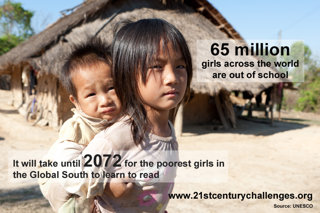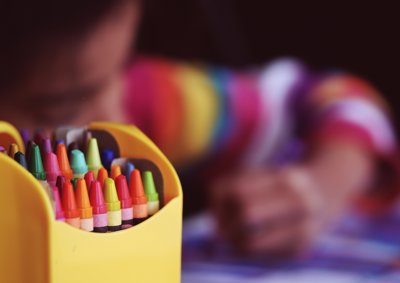To almost every child in the developed world, education has an unquestionable presence in their lives. The thought of reaching adulthood and not having a degree of basic literacy and numeracy that will enable them to work and provide for themselves at some level is inconceivable.
Yet despite significant improvements in the numbers of children who are attending and completing primary and secondary to many children who come from poor and developing nations, education becomes far less of a right and far more of a privilege. School fees remain the number one barrier to a world where every child attends primary school up to the age of 11, if not beyond to complete their education with a high school qualification. Some children never begin any form of education, while others leave their classrooms prematurely as other economic and social pressures are found in their families. Nowhere is this truer than in the education of girls and a clear divide is frequently witnessed in the literacy rates of boys and girls.
Equalising education is not just about closing the education and skills gap between developed and developing countries but also about ensuring that regardless of gender, everyone has the right to a good education.

What’s the challenge?
Millions of girls and young women across the world still face huge barriers to education. What are these barriers and what inspirational initiatives are working to help overcome them? How can their success be replicated to ensure that young people everywhere have the human right to education and we empower girls to the benefit of everyone?
The Millennium Development Goals
The Millennium Development Goals galvanised unprecedented efforts to meet the needs of the world’s poorest. The Third Millennium Development Goal aimed to:
-
Eliminate gender disparity in primary and secondary education, preferably by 2005, and by all levels of education no later than 2015.
-
Increase the number of paid employment in women outside of the agricultural sector.
-
Increase the number of female MPs
The good news is that almost all countries have achieved, or are close to achieving gender equality in primary education with the notable exceptions of Afghanistan and Pakistan. More girls are enrolled in primary school than ever before and in Nepal and Bangladesh the gender disparity even favours girls.
The bad news is that vast disparities still remain at higher levels of education, particularly in Africa and South Asia, drop-out rates remain high, and worldwide 126 million young people still lack basic reading and writing skills with women accounting for more than 60 per cent.
Barriers to education
-
Poverty means women and girls in many parts of the world are still forced to spend hours a day doing chores, fetching water and caring for relatives and boys sent over girls with limited funds
-
Unsafe roads leading to schools
-
Lack of sanitation facilities in schools
-
Lack of security in schools: Dramatically highlighted by Malala Yousafzai, shot by the Taliban on her way to school for speaking out about education rights, and the kidnapping this year of 276 school girls by the militant Islamist movement Boko Haram and the resulting Bring Back Our Girls campaign.
-
Sexual violence and discrimination and are not allowed to continue school if they become pregnant or forced into child marriage.
-
Lack of female role models
-
A tradition and culture of not valuing girls education
The benefits of educating girls
There are many benefits of educating girls. These include:
-
Education increases the likelihood that women will look after their own wellbeing along with that of their family.
-
Educated women in rural areas are more likely to participate in decision-making and are less likely to suffer from domestic violence.
-
Education gives women access to better economic opportunities, provides empowerment and enables women to have control over their lives and exert influence in society.
Employment
Because of barriers, globally women still enter the job market on an unequal basis to men, hold less secure jobs, and have fewer rights to land ownership and opportunities outside the agricultural sector. Women are typically paid less and have less financial and social security than men and globally only one quarter of senior officials or managers are women.
Women perform 66% of the world’s work, and produce 50% of the food, yet earn only 10% of the income and own 1% of the property.
Gaining equal access to employment opportunities outside of the agricultural sector will increase the income and property gained by women. It has also been shown that women usually invest a higher proportion of their earnings in their families and communities than men. The largest improvements in employment have been made in Latin America and the Caribbean. (Sources: Worldbank, OECD, FAO)
Government
Better news can be seen for the target’s third indicator of increasing the number of female MPs. Globally, women’s political participation has increased, largely thanks to quotas and by the end of 2013, only five chambers worldwide had no women in parliament, but glass ceilings remain.
Political participation among women has increased. Globally women now make up 18.6 percent of parliamentarians. In January 2014 more than 30 per cent of members of parliament in at least one chamber were women in 46 countries. (Sources: OECD, Global Urban Development, UN Women)
Rwanda was the first country in the world to elect more women parliamentarians than men and now has the highest number of female parliamentarians in the world at 56.3%.
The Royal Geographical Society (with IBG) held a panel discussion on 20 November 2014 to discuss the issue.
Hear about this challenge from:
Louise Tickle (Chair), Education and social affairs journalist
Ann Cotton OBE, Founder and President of Camfed International
Ann is widely recognised and respected as an example of best practice in girls’ education. Originating in Cambridge, UK, Camfed’s model has now been replicated in more than 3,428 communities in Ghana, Malawi, Tanzania, Zambia, and Zimbabwe
“It’s often about changing the culture in the school system, because it’s not only about getting girls into schools. Schools are often largely male environments, and girls participate as a minority, as a result of which they don’t do well academically. It’s about saying ‘you are as important as everyone else in the school system’, and the leadership getting behind this idea.” Ann Cotton
Elaine Unterhalter, Professor of Education and International Development, Institute of Education, London.
She has more than 25 years experience working on themes concerned with gender, race and class inequalities and their bearing on education. Her specialist interests are in the capability approach and human development and education in Africa, particularly South Africa. Her current concerns are with education, poverty and global social justice and she is working with a number of UN agencies on aspects of gender and the MDGs.
“In Sub Saharan Africa and in low income countries the number of children out of school has not come down enough.” Elaine Unterhalter
“The number of children out of school is an area in which inequality, poverty, violence, misogyny and injustice of a society takes particular gender shapes.” Elaine Unterhalter
Further reading
Mapping gender inequality, Geographical Magazine, April 2015
Women and the informal economy – Palestine, Geography Directions, October 2010
Women and education – Yemen, Geography Directions, October 2010
